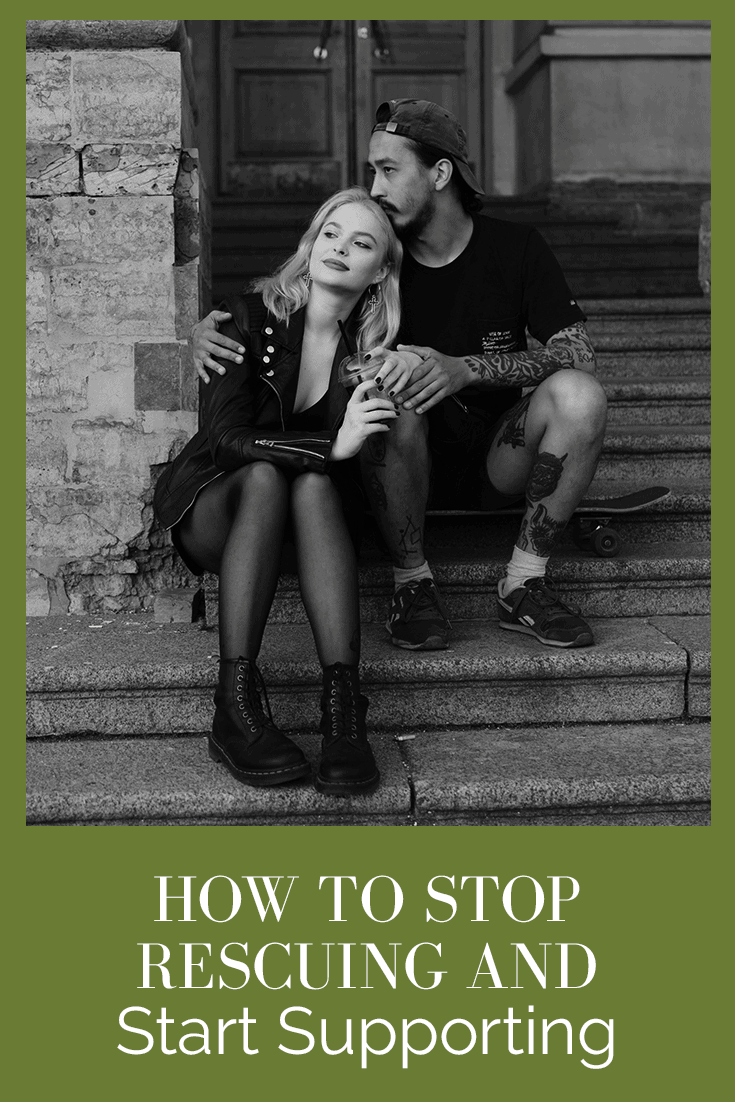
6-minute read
Prefer to listen to the podcast? Click here!
I’ve got a quick quiz for you: Do you think you know what’s best for others and do stuff for them even when they didn’t ask? Do you put in more time and effort thinking about your partner’s issues than they do? Do you feel like others don’t appreciate what you do and get resentful? Do you have trouble relaxing if someone you love is unhappy? If you’re answering “yes,” you are likely a rescuer and it’s keeping you stuck, disconnected and dissatisfied in your relationships. As always, I’m here to help. Today you’ll learn my four simple steps to stop rescuing so you can start truly connecting and supporting the people in your life.
On the other side is rescuing and codependency and these don’t feel good because they’re driven by fear. Fear of abandonment and rejection and feelings of low self-worth. These emotions create more fear, distance and anxiety.
So how do you know if you’re being supportive, which is healthy, or codependent and rescuing, which is unhealthy?
To help you understand, I’m going to walk you through a real-life example that I’ve no doubt you’ll relate to.
I worked with a couple a little while ago whom we’ll call Jack and Diane. Diane complained pretty often that she didn’t feel like Jack had her back, especially when it came to “his side of the family.”
At Christmas in 2019, they’d planned an extended family vacation with Jack’s parents. Diane has a particular problem with Jack’s mom who was super opinionated about just about everything. Diane, being a strong personality herself, felt like she was in a constant struggle with Jack’s mom and that Jack didn’t have her back: “He abandons me and leaves me on my own to deal with his mom and it drives me crazy!”
Cue Christmas Eve dinner and Jack’s mom was on a rant about how Jack and Diane were raising their teenagers. She and Diane ended up arguing at the dinner table. Jack said he tried to intervene a couple of times, but it didn’t work: “I said, ‘Hey, let’s all relax and have a nice dinner’ the first time and ‘Let’s change the subject’ the second time but they just kept at it!”
Jack ended up leaving the table for about 20 minutes. When he finally came back and they were still arguing, he became enraged and attacked his mother. He ended up raising his voice and telling her that she was upsetting everyone with her craziness and she needed to stop harassing Diane. As you might imagine, this created even more tension between Jack’s mom and Diane over the next few days and Diane was very angry with Jack.
Jack was at a loss. “I tried to intervene nicely but that didn’t work. Then I left and that didn’t work. Then I finally made my mother shut up, but Diane is angry about all of it and saying I didn’t have her back! What the hell should I have done!?”
Jack was codependent, avoidant and rescuing but not supportive. We’re going to break this down right now, so you can see why none of this was supportive. This will help you figure out how to do this on your own in the future.
So, let’s look at what happened.
- This arguing was making Jack anxious and uncomfortable, so he was having fear-based emotions but he never spoke to them (more fear)
- Being a conflict avoider (with that mom you can understand why), he went with the dismissive, minimizing and fear-based response: “Let’s all relax and have a nice dinner” and “Let’s change the subject.” Again, he wasn’t honest about what he was feeling so nothing changed. Remember, you’ve got to connect to correct. You connect with vulnerable, real feelings. Since he wasn’t giving them these, they weren’t OK with being “corrected.”
- He wasn’t honest. He wasn’t vulnerable. When things weren’t going like he wanted, he felt helpless (more fear) and left the table; abandonment is all about fear.
- Yelling at his mom was fear-based obviously. And he was rescuing Diane instead of supporting her. People need to stand up for themselves, but know that you’re there for them and have their back when they do.
- This is putting Diane in a bad light as he was the knight in shining armor and she’s the damsel in distress who can’t speak up for herself – the mom resented it and so did Diane.
In these situations, you’ve got to come from a love-based emotions: compassion, kindness, patience and vulnerability, not from the fear-based emotions: avoidance, dismissiveness, minimizing, deflecting, anger, attacking, defensiveness or anxiety.
What to do instead:
Step 1: Notice yourself in the moment and be in the here-and-now.
Step 2: Identify what you’re actually feeling.
Step 3: Share how you’re feeling – be vulnerable: “I’m feeling so sad and disconnected watching the two of you.” He could’ve spoke directly to his wife at that point: “Are you OK? It’s painful to watch you being upset. What do you need from me right now?” Or he could have said to his mom: “I’m feeling sad about what’s happening. How can we do these dinners differently? I want to connect with you and feel close and I just don’t right now.” You can use the I Feel Statement here! (Scroll down to the bottom to get the I Feel Statement exercise)
Step 4: Be in love solidarity, not fear solidarity. If you jump in to “save” the other person, that’s fear solidarity. Let them stand up for themselves and be there in love solidarity. If your partner wants to leave – then leave with them. But mostly, your partner just wants you to see that something’s tough for them and know that you see and understand! You don’t have to “do” anything! Connect with your partner in this instance. Show them you’re there and will support what they feel needs to happen next. By doing this, you’re validating their feelings which is key!
If your partner wants you to never speak to your mother again to show you have their back, that’s not love solidarity, because those kinds of cutoffs are coming from fear. You want to work with your partner to feel more supported by you when you all interact but don’t be codependent. Don’t step in with threats or pleas to your mom. This does NOT help your partner and mom improve their relationship!
Don’t fix things. That’s rescuing. Remember not to SAC and instead to ask questions to help people find their way. Be their cheerleader and support. Let them know you’re there next to them for whatever emotional support they need but you’re not there for physical support – meaning, you won’t talk to your mom for your partner. You won’t intervene and try to rescue your partner. You won’t avoid the issue either! You’re fully there to emotionally support the other person.
RESOURCES
The Secret to Making Boundaries, Not Walls
Boundaries: How to Make Them, How to Hold Them
Don’t SAC! 8 Rules to Giving Great Feedback






